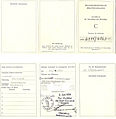Refugee ID card
Refugee ID is an official document proving certain circumstances.
Germans after World War II
Displaced persons and refugees from the Soviet zone received an “ ID card for displaced persons and refugees ” based on a model from the Federal Minister for Displaced Persons as proof of their displaced or refugee status in accordance with Section 15 of the Federal Expellees Act of 1953 (BVFG) .
Displaced received the ID A , displaced the card B and Russian zone refugees the card C . The ID entitles the holder to avail of the rights and benefits under the BVFG. The issuance of the ID card also resulted in collective naturalization pursuant to Article 116 (1) of the Basic Law by law .
Before the BVFG came into force, Lower Saxony municipalities also issued a B refugee permit for residents who had moved in after the bombing.
- ID cards for displaced persons and refugees
Asylum seekers in the Federal Republic of Germany
Since January 28, 2016, refugees in the Federal Republic of Germany have initially received proof of arrival upon arrival . If you have applied for asylum, you will receive a residence permit ; the proof of arrival is withdrawn at the same time ( Section 63a (4) sentence 2 AsylG). If they are recognized as entitled to asylum in the asylum procedure or if they are granted refugee status, they will receive a travel document for refugees and a residence permit .
See also
Web links
Individual evidence
- ↑ The most important reasons for acquiring German citizenship, overview. Kleve district website , accessed on October 21, 2017
- ^ Asylum seekers: Iraqis receive first refugee ID card in Germany Der Spiegel , January 28, 2016


